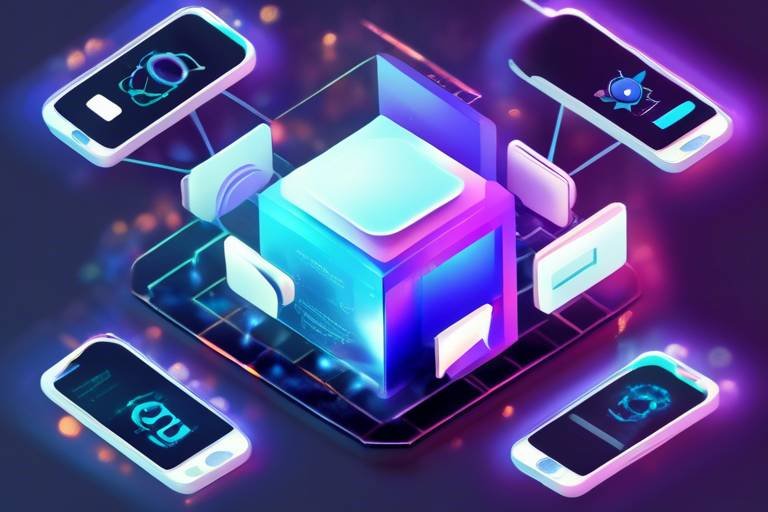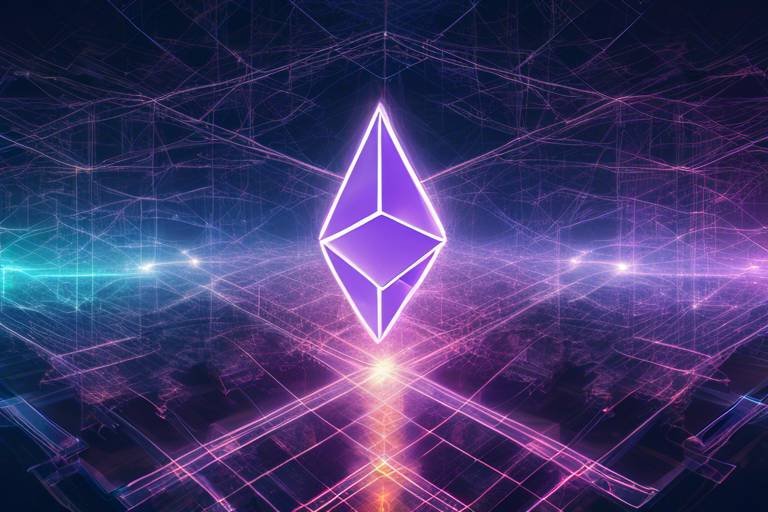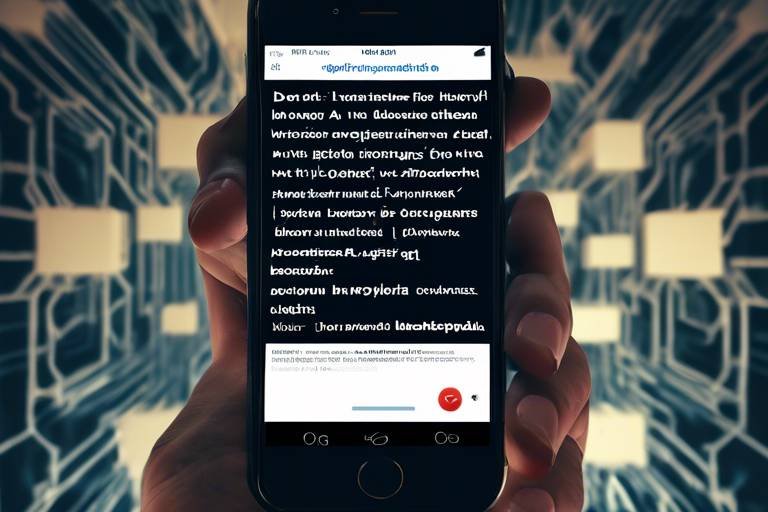Flare - Bringing Smart Contracts to XRP
In the rapidly evolving world of blockchain technology, the integration of smart contracts has become a game-changer for various networks, and Flare is at the forefront of this revolution, particularly for the XRP Ledger. Imagine a world where transactions are not just simple transfers of value but are also governed by automated, self-executing contracts that eliminate the need for intermediaries. This is precisely what Flare aims to achieve. By introducing smart contracts to the XRP ecosystem, Flare enhances its functionality, allowing developers to create decentralized applications that can operate seamlessly and efficiently.
So, why is this significant? The introduction of smart contracts on the XRP Ledger opens up a plethora of possibilities, from decentralized finance (DeFi) solutions to innovative applications in gaming and supply chain management. It’s like adding a turbocharger to a high-performance car; it doesn’t just make it faster—it transforms the entire driving experience. In this article, we will dive deep into Flare's architecture, its interoperability features, and the myriad of use cases that can emerge from this integration.
Flare is not just a simple add-on; it is a layer-1 blockchain specifically designed to bridge the gap between networks that lack smart contract capabilities and those that are rich in features like XRP. This layer acts as a catalyst, enabling existing blockchains to leverage the power of decentralized applications without compromising their original functionalities. Just as the internet revolutionized communication, Flare is set to revolutionize how we interact with blockchain technology.
As we explore the mechanics behind Flare, you'll discover how its unique architecture and consensus mechanisms work together to create a robust environment for smart contracts. This is not merely a technical discussion; understanding Flare's inner workings is crucial for grasping its potential impact on the blockchain ecosystem as a whole. So buckle up, as we delve into the exciting world of Flare and its promise for the future of XRP!
- What are smart contracts? Smart contracts are self-executing contracts with the terms of the agreement directly written into code, allowing for automated and secure transactions.
- How does Flare enhance the XRP Ledger? Flare integrates smart contract functionality into the XRP Ledger, enabling new decentralized applications and improving transaction efficiency.
- What are the benefits of using Flare? Benefits include increased automation, reduced reliance on intermediaries, and enhanced capabilities for decentralized finance and other applications.
- Can Flare work with other blockchains? Yes, Flare is designed for interoperability, allowing it to communicate and transact with various blockchain networks.

What is Flare?
Flare is a cutting-edge layer-1 blockchain designed to bring smart contract capabilities to networks that traditionally lack them, with a special focus on the XRP Ledger. Imagine a world where the limitations of existing blockchain technologies are pushed aside, allowing developers to create innovative applications that were previously impossible. Flare aims to do just that by enhancing the functionality of the XRP ecosystem and enabling a new wave of decentralized applications (dApps).
At its core, Flare operates on a unique foundational technology that combines the best aspects of various blockchain architectures. It leverages the power of the XRP Ledger while introducing the flexibility of smart contracts, which are self-executing contracts with the terms of the agreement directly written into code. This means that transactions can be automated, reducing the need for intermediaries and increasing efficiency. With Flare, developers can build applications that can interact seamlessly with XRP, unlocking a plethora of possibilities.
One of the standout features of Flare is its ability to provide interoperability with other blockchain networks. This is crucial in today's fragmented blockchain landscape, where different networks often operate in silos. By facilitating communication and transactions between various blockchains, Flare not only enhances its own ecosystem but also contributes to the overall growth of the blockchain industry. Think of it as a bridge connecting isolated islands of technology, allowing for a more integrated and collaborative environment.
Additionally, Flare employs a unique consensus mechanism that ensures security and reliability. This mechanism is designed to be energy-efficient, which is a significant advantage in an era where environmental concerns are becoming increasingly important. The combination of these technological advancements positions Flare as a pivotal player in the evolution of blockchain technology, particularly for those who are already invested in the XRP Ledger.
In summary, Flare is not just another blockchain; it is a transformative platform that aims to enhance the capabilities of existing networks like XRP. Its smart contracts, interoperability features, and innovative consensus mechanism make it a game-changer in the blockchain space. As we delve deeper into this article, we will explore how Flare works, the benefits it brings to the XRP Ledger, and the exciting use cases it opens up for developers and users alike.

How Flare Works
Understanding how Flare operates is crucial to appreciating its significance within the XRP ecosystem. At its core, Flare utilizes a unique architecture and consensus mechanism that set it apart from traditional blockchain systems. The integration of smart contracts into the XRP Ledger isn't just an enhancement; it's a transformation that opens doors to a plethora of possibilities.
Flare's architecture is layered, which means it is designed to work harmoniously with existing blockchains, particularly the XRP Ledger. This layered approach allows for seamless integration without disrupting the underlying network. Imagine a multi-layered cake; each layer adds its own flavor and texture without compromising the overall structure. Similarly, Flare enhances the XRP ecosystem without altering its foundational components.
The layered architecture of Flare is one of its standout features. It comprises several components that work together to ensure scalability and interoperability. The primary layers include:
- Flare Network Layer: This is where the smart contracts live and operate, enabling the execution of complex transactions.
- Consensus Layer: Flare employs a unique consensus mechanism known as the Federated Byzantine Agreement (FBA), which allows for rapid transaction validation while maintaining decentralization.
- Interoperability Layer: This layer ensures that Flare can communicate effectively with other blockchain networks, facilitating cross-chain transactions.
This architecture not only enhances the functionality of XRP but also ensures that it can scale effectively as demand grows. By allowing different layers to specialize in various tasks, Flare can handle a larger volume of transactions without sacrificing speed or efficiency.
Interoperability is a buzzword in the blockchain space, and for good reason. Flare's ability to communicate with other networks is crucial for its success. It employs several features to ensure that it can interact with different blockchains, including:
- Wrapped Tokens: Flare allows users to create wrapped versions of assets from other blockchains, making it easier to utilize them within its ecosystem.
- Cross-Chain Communication Protocols: These protocols enable transactions between Flare and other networks, enhancing liquidity and accessibility.
Thanks to these interoperability features, Flare not only enhances the XRP Ledger but also creates a bridge to other blockchain ecosystems, fostering collaboration and innovation.
Decentralized oracles are another key component of Flare's functionality. These oracles serve as a bridge between smart contracts and real-world data, enabling the execution of contracts based on external information. For instance, if a smart contract needs to verify the price of a commodity or the outcome of a sporting event, a decentralized oracle can fetch this data and relay it to the contract. This capability significantly enhances the usability of smart contracts, making them more versatile and applicable across various industries.
In essence, Flare's innovative mechanics and architecture empower the XRP Ledger to embrace the future of decentralized applications. By integrating smart contracts, enhancing interoperability, and utilizing decentralized oracles, Flare is paving the way for a more dynamic and efficient blockchain ecosystem.
Q1: What is Flare?
A1: Flare is a layer-1 blockchain designed to bring smart contract capabilities to networks that lack them, focusing primarily on the XRP Ledger.
Q2: How does Flare enhance the XRP Ledger?
A2: Flare integrates smart contracts into the XRP Ledger, allowing for automated and efficient transactions, as well as enabling new decentralized applications.
Q3: What is the consensus mechanism used by Flare?
A3: Flare uses a Federated Byzantine Agreement (FBA) consensus mechanism, which allows for fast transaction validation while maintaining decentralization.
Q4: How does Flare ensure interoperability with other blockchains?
A4: Flare employs wrapped tokens and cross-chain communication protocols to facilitate transactions and interactions with other blockchain networks.
Q5: What role do decentralized oracles play in Flare?
A5: Decentralized oracles provide external data to smart contracts, enhancing their functionality and making them applicable in real-world scenarios.

Layered Architecture
The of Flare is a game-changer, designed to revolutionize how blockchains interact with one another. Imagine a multi-story building where each floor serves a distinct purpose; this is similar to how Flare organizes its functionalities. At the base, you have the foundational layer, which is responsible for the core operations of the blockchain. Above that, additional layers are built to handle specific tasks, such as smart contracts and interoperability with other networks like the XRP Ledger.
This architectural design not only enhances scalability but also ensures that Flare can adapt to the ever-evolving needs of the blockchain ecosystem. By separating functionalities into different layers, Flare can process transactions more efficiently, reducing congestion and transaction times. For instance, while one layer manages smart contracts, another can focus on validating transactions, allowing for smooth operations without bottlenecks. This separation of concerns is crucial in a world where speed and efficiency are paramount.
Moreover, the layered approach allows developers to build decentralized applications (dApps) without worrying about the underlying complexities of the blockchain. They can focus on creating innovative solutions that leverage the capabilities of Flare, knowing that the architecture will support their needs. This is akin to how a chef can create a gourmet dish without needing to understand the intricacies of the kitchen's plumbing or electrical systems.
To better illustrate the benefits of Flare's layered architecture, consider the following table that outlines the different layers and their primary functions:
| Layer | Function |
|---|---|
| Base Layer | Handles core blockchain operations and security |
| Smart Contract Layer | Enables the creation and execution of smart contracts |
| Interoperability Layer | Facilitates communication with other blockchains, including XRP |
In summary, Flare's layered architecture not only enhances its performance but also opens the door for exciting innovations. By allowing for seamless integration with existing blockchains, it creates an ecosystem where different networks can thrive together. This collaborative environment is essential for the future of blockchain technology, as it promotes the sharing of resources and ideas across platforms. So, if you're excited about the potential of blockchain, keep an eye on Flare—it's paving the way for a more interconnected digital world!

Interoperability Features
Interoperability is a game-changer in the world of blockchain technology, and Flare takes this concept to heart. By allowing different blockchain networks to communicate and transact with one another, Flare significantly enhances the utility of the XRP Ledger. Imagine a bustling marketplace where vendors from different towns can trade their goods seamlessly; that’s the vision Flare brings to the blockchain ecosystem. With its unique architecture, Flare ensures that various networks can interact without friction, paving the way for a more connected digital landscape.
One of the standout features of Flare's interoperability is its ability to support multiple assets and tokens across different platforms. This means that users can easily transfer assets from the XRP Ledger to other blockchains and vice versa. The implications of this capability are enormous, as it opens up avenues for liquidity and trading that were previously unavailable. For instance, a user could leverage the speed of XRP for transactions while utilizing the smart contract functionalities of Flare, creating a hybrid experience that maximizes the strengths of both platforms.
Furthermore, Flare employs a system of bridges that connect various blockchains. These bridges act like highways, facilitating the smooth transfer of data and assets. With these connections, developers can create decentralized applications (dApps) that harness the power of multiple blockchains, thereby enriching user experiences. The potential for innovation is vast, as developers can tap into the unique features of each blockchain to build applications that are more robust and versatile.
Another critical aspect of Flare's interoperability is its integration with decentralized oracles. These oracles serve as the eyes and ears of the blockchain, fetching real-world data that can be used within smart contracts. This means that smart contracts on Flare can react to real-time events, such as price changes or market conditions, making them far more dynamic and useful. For example, imagine a smart contract that automatically adjusts the terms of a loan based on current interest rates; this is the kind of flexibility that Flare enables.
In summary, Flare's interoperability features are not just technical specifications; they represent a paradigm shift in how blockchains can work together. By breaking down silos and fostering collaboration between networks, Flare is setting the stage for a future where decentralized applications can thrive on a global scale. As we continue to explore the potential of Flare, it becomes clear that its interoperability is a cornerstone of its design, promising to unlock new possibilities for developers and users alike.
- What is Flare? Flare is a layer-1 blockchain designed to bring smart contract capabilities to networks like the XRP Ledger.
- How does Flare enhance interoperability? Flare allows different blockchains to communicate and transact with each other, increasing liquidity and usability.
- What role do decentralized oracles play in Flare? They provide external data to smart contracts, enhancing their functionality and allowing them to react to real-world events.
- Can I transfer assets between XRP and Flare? Yes, Flare supports the transfer of assets between the XRP Ledger and other blockchains.

Decentralized Oracles
Decentralized oracles are the unsung heroes of the blockchain world, playing a pivotal role in enhancing the functionality of smart contracts on platforms like Flare. But what exactly is an oracle? In the simplest terms, an oracle is a bridge between the blockchain and the outside world, providing smart contracts with real-time data that they need to execute. Without oracles, smart contracts would be like a ship lost at sea, unable to navigate without reliable information about their surroundings.
Flare’s decentralized oracles are designed to pull data from various external sources, ensuring that the information fed into smart contracts is accurate and tamper-proof. This is crucial because the effectiveness of a smart contract often hinges on the quality of the data it processes. For instance, consider a smart contract that manages a decentralized finance (DeFi) lending platform. This contract would need up-to-date price feeds for various cryptocurrencies to determine loan amounts, interest rates, and liquidation thresholds. If the data is incorrect or delayed, it could lead to significant financial losses for users.
One of the standout features of Flare’s decentralized oracles is their ability to aggregate data from multiple sources. This aggregation not only enhances the reliability of the information but also mitigates the risks associated with relying on a single data source. Imagine trying to predict the weather by only checking one app; you might get a skewed perspective. However, by consulting multiple weather services, you can form a more accurate picture. Similarly, Flare's oracles compile data from various providers, ensuring that smart contracts operate on the most accurate and current information available.
Moreover, the decentralized nature of these oracles means that they are less susceptible to manipulation. In traditional systems, a single point of failure can lead to catastrophic consequences. However, with decentralized oracles, the consensus of multiple data sources is required, making it significantly harder for malicious actors to alter the outcomes of smart contracts. This decentralization fosters trust among users, as they can be confident that the data driving their transactions is reliable and secure.
To illustrate how Flare’s decentralized oracles work, consider the following table:
| Oracle Source | Data Type | Frequency of Updates |
|---|---|---|
| Crypto Price Feed | Cryptocurrency prices | Every minute |
| Weather API | Weather conditions | Every 10 minutes |
| Stock Market Data | Stock prices | Every second |
As you can see, Flare's oracles can pull data from various sources at different frequencies, ensuring that smart contracts have access to the most relevant and timely information. This versatility not only enhances the functionality of decentralized applications (dApps) built on Flare but also opens up a world of possibilities for innovation across various sectors.
In summary, decentralized oracles are a critical component of Flare's ecosystem, enabling smart contracts to operate effectively and efficiently. By providing reliable, real-time data from multiple sources, they enhance the overall security and functionality of decentralized applications on the XRP Ledger. As the blockchain landscape continues to evolve, the importance of decentralized oracles will only grow, making them an essential element for developers and users alike.
- What is the role of decentralized oracles in smart contracts? Decentralized oracles serve as bridges between blockchains and external data sources, providing smart contracts with the real-time information they need to function correctly.
- How does Flare ensure the reliability of its oracles? Flare aggregates data from multiple sources, reducing the risk of relying on a single point of failure and enhancing the overall accuracy of the information.
- Why are decentralized oracles important for the DeFi space? In DeFi, accurate and timely data is crucial for determining loan amounts, interest rates, and other financial metrics. Decentralized oracles ensure that this data is trustworthy and current.

Benefits of Smart Contracts on XRP
Smart contracts are often hailed as the backbone of the blockchain revolution, and when integrated with the XRP Ledger, they bring a plethora of benefits that can transform the way we conduct transactions. Imagine a world where contracts execute themselves automatically, without the need for intermediaries. That's the power of smart contracts on XRP! By leveraging the efficiency and speed of the XRP Ledger, these contracts can enhance transaction processes, making them not only faster but also more reliable.
One of the most significant advantages of implementing smart contracts on the XRP Ledger is automation. Traditional contracts often require manual oversight, which can lead to delays and errors. With smart contracts, once the conditions are met, the contract executes automatically. This means that payments can be made instantly, and agreements can be fulfilled without human intervention. For example, consider a simple scenario where a freelancer completes a project. With smart contracts, the payment can be released immediately upon completion, eliminating the waiting period that often frustrates both parties.
Moreover, smart contracts enhance transparency. Every transaction recorded on the XRP Ledger is immutable and publicly accessible, ensuring that all parties involved can verify the terms of the contract and the status of the transaction. This level of transparency builds trust among users, as it minimizes the risk of disputes and fraud. In a world where trust is paramount, especially in financial transactions, this feature is invaluable.
Additionally, the integration of smart contracts on XRP introduces a new level of cost efficiency. By removing intermediaries and automating processes, businesses can significantly reduce transaction costs. This is particularly beneficial for industries that rely heavily on contracts, such as real estate, finance, and supply chain management. For instance, in supply chain management, smart contracts can automate the release of payments once goods are delivered, streamlining the entire process and cutting down on administrative costs.
Furthermore, the flexibility of smart contracts allows for the creation of customized agreements that can cater to specific needs. Businesses can design contracts that include complex conditions, such as multi-signature requirements or conditional payments. This adaptability opens up a world of possibilities for innovative applications. For example, in the realm of decentralized finance (DeFi), smart contracts can facilitate lending and borrowing without the need for traditional banks, thus democratizing access to financial services.
In summary, the benefits of smart contracts on the XRP Ledger are manifold. They provide automation, transparency, cost efficiency, and flexibility, all of which contribute to a more streamlined and reliable transaction process. As we continue to explore the potential of blockchain technology, the integration of smart contracts with XRP is set to pave the way for a new era of decentralized applications that can revolutionize various industries.
- What are smart contracts? Smart contracts are self-executing contracts with the terms of the agreement directly written into code. They automate and enforce contractual agreements without needing intermediaries.
- How do smart contracts improve transactions on the XRP Ledger? Smart contracts enhance transactions by automating processes, ensuring transparency, and reducing costs associated with traditional contract management.
- Can smart contracts be customized? Yes, smart contracts can be tailored to meet specific needs, allowing for complex conditions and various use cases across different industries.

Use Cases for Flare
Flare is not just a technological marvel; it's a gateway to a plethora of innovative applications that can reshape how we interact with the XRP Ledger. Imagine a world where finance, gaming, and supply chain management are not only streamlined but also more secure and efficient. With Flare's smart contract capabilities, this vision is becoming a reality. Let’s explore some of the most exciting use cases that Flare brings to the table.
One of the most significant areas where Flare can make a splash is in Decentralized Finance (DeFi). DeFi has taken the crypto world by storm, offering users the ability to lend, borrow, and trade without the need for intermediaries. With Flare, the XRP Ledger can host a variety of DeFi applications, allowing for seamless transactions and enhanced liquidity. Imagine being able to earn interest on your XRP holdings or participate in yield farming—all automated through smart contracts. This level of accessibility and efficiency can open doors for many who were previously excluded from traditional financial systems.
In addition to DeFi, Flare is poised to revolutionize the world of Non-Fungible Tokens (NFTs). NFTs have gained immense popularity as a means of representing digital ownership, from art to virtual real estate. With Flare, creators can mint and trade NFTs directly on the XRP Ledger, leveraging its speed and low transaction costs. This not only expands the utility of NFTs but also attracts a broader audience to the XRP ecosystem. Imagine a digital art gallery where artists can showcase their work and collectors can purchase unique pieces, all secured by the power of smart contracts.
Moreover, Flare can significantly enhance Supply Chain Management. The ability to track products from origin to consumer is crucial for transparency and trust. By utilizing smart contracts, Flare can automate and verify each step in the supply chain process. For instance, when a product is shipped, a smart contract could automatically update its status on the blockchain, providing real-time tracking information to all stakeholders. This not only improves efficiency but also reduces fraud and errors, creating a more reliable supply chain.
These use cases are just the tip of the iceberg. With Flare's capabilities, the potential for new applications is virtually limitless. From gaming platforms that reward players with cryptocurrencies to decentralized marketplaces that facilitate peer-to-peer transactions, Flare is paving the way for a more interconnected and efficient blockchain ecosystem. As developers continue to explore these possibilities, we can expect to see a surge in innovative applications that leverage the unique strengths of the XRP Ledger.
- What is Flare? Flare is a layer-1 blockchain that brings smart contract functionality to the XRP Ledger, enabling a range of decentralized applications.
- How does Flare enhance the XRP Ledger? By integrating smart contracts, Flare allows for automated transactions and interactions, increasing efficiency and opening new avenues for development.
- What are some potential applications of Flare? Flare can be used in various sectors, including DeFi, NFTs, and supply chain management, among others.
- Is Flare compatible with other blockchains? Yes, Flare's architecture is designed for interoperability, allowing it to communicate and transact with multiple blockchain networks.

Decentralized Finance (DeFi)
Decentralized Finance, commonly known as DeFi, represents a revolutionary shift in how we think about and engage with financial systems. At its core, DeFi leverages blockchain technology to create an open and permissionless financial ecosystem that operates without traditional intermediaries like banks or brokers. Imagine a world where you have complete control over your assets, where you can lend, borrow, and trade without the need for a middleman. That’s the magic of DeFi, and with Flare's integration of smart contracts into the XRP Ledger, this vision becomes even more attainable.
One of the most exciting aspects of DeFi on the Flare network is its potential to democratize access to financial services. Traditionally, access to banking and investment opportunities has been limited to those who meet certain criteria, often leaving many individuals excluded. However, with DeFi, anyone with an internet connection can participate. This opens up a world of possibilities, especially for those in underbanked regions. For example, users can engage in activities such as:
- Lending and Borrowing: Users can lend their assets and earn interest, or borrow against their holdings without the lengthy approval processes typical of banks.
- Yield Farming: Investors can stake their assets in various protocols to earn rewards, often resulting in higher returns compared to traditional savings accounts.
- Liquidity Pools: By providing liquidity to decentralized exchanges, users can earn fees from trades, contributing to a more efficient market.
Flare enhances these DeFi functionalities by providing a robust and scalable environment. The integration of smart contracts allows for the automation of complex financial transactions, reducing the risk of human error and increasing efficiency. Moreover, the use of decentralized oracles ensures that these smart contracts can access real-world data, such as price feeds, which is crucial for executing trades and managing collateral in lending platforms.
To illustrate the impact of Flare on DeFi, consider a simple comparison of traditional finance versus DeFi:
| Aspect | Traditional Finance | Decentralized Finance (DeFi) |
|---|---|---|
| Access | Restricted to bank account holders | Open to anyone with internet access |
| Intermediaries | Banks and financial institutions | No intermediaries; peer-to-peer transactions |
| Transaction Speed | Can take days | Near-instant transactions |
| Fees | High fees for services | Lower fees, often negligible |
The transition from traditional finance to DeFi is not without its challenges, however. Issues such as security risks, regulatory scrutiny, and the volatility of cryptocurrencies can pose significant hurdles. Nevertheless, the potential for innovation and financial inclusion is immense. As more users adopt Flare’s smart contract capabilities on the XRP Ledger, we can expect to see an explosion of DeFi applications that cater to diverse financial needs.
In conclusion, Flare's introduction of smart contracts to the XRP Ledger is not just a technical upgrade; it's a gateway to a new era of financial freedom. DeFi empowers individuals by providing them with tools to take control of their financial destinies, and with Flare at the forefront, this revolution is just beginning.
- What is DeFi? DeFi stands for Decentralized Finance, which refers to financial services that operate on blockchain technology without intermediaries.
- How does Flare enhance DeFi? Flare integrates smart contracts into the XRP Ledger, allowing for automated, efficient, and secure financial transactions.
- Can anyone participate in DeFi? Yes, anyone with an internet connection can access DeFi services, making it more inclusive than traditional finance.
- What are some risks associated with DeFi? Risks include security vulnerabilities, regulatory challenges, and the inherent volatility of cryptocurrencies.

Non-Fungible Tokens (NFTs)
Non-Fungible Tokens, or NFTs, are like digital collectibles that have taken the internet by storm. Imagine owning a one-of-a-kind painting, but instead of hanging it on your wall, you own it in a digital space. Each NFT is unique and cannot be exchanged for something else on a one-to-one basis, hence the term "non-fungible." With Flare integrating smart contract capabilities into the XRP Ledger, the potential for NFTs is expanding exponentially.
So, what does this mean for creators and collectors? First off, Flare's infrastructure allows artists and developers to mint, buy, and sell NFTs seamlessly. The integration with the XRP Ledger provides a robust platform that enhances transaction speed and reduces costs, making it more accessible for everyone involved. Imagine being able to create and trade NFTs without worrying about high gas fees or slow transaction times—this is the future that Flare is paving the way for.
Furthermore, Flare's decentralized oracles play a crucial role in the NFT ecosystem. They can provide real-time data about the NFT's provenance, ownership history, and market value. This transparency not only builds trust among collectors but also empowers creators by giving them more control over their digital assets. Artists can set royalties for secondary sales, ensuring they continue to benefit as their work appreciates in value.
In the world of NFTs, the use cases are virtually limitless. Here are some exciting possibilities:
- Art and Music: Artists can tokenize their work, allowing for fractional ownership and making it easier for fans to invest in their favorite creators.
- Gaming: In-game assets can be represented as NFTs, giving players true ownership of their items and the ability to trade them across different games.
- Virtual Real Estate: Users can buy, sell, and trade virtual land and properties in digital worlds, creating new economic opportunities.
As the NFT market continues to evolve, Flare's integration with the XRP Ledger positions it as a significant player in this space. By providing a scalable and efficient platform, Flare empowers creators and collectors alike, making the world of NFTs more vibrant and accessible. The future of digital ownership is here, and it’s being shaped by innovative technologies like Flare.
Q: What is an NFT?
A: An NFT, or Non-Fungible Token, is a unique digital asset that represents ownership of a specific item or piece of content, such as art, music, or virtual real estate. Unlike cryptocurrencies like Bitcoin, NFTs cannot be exchanged on a one-to-one basis.
Q: How does Flare enhance NFTs on the XRP Ledger?
A: Flare brings smart contract capabilities to the XRP Ledger, allowing for seamless minting, buying, and selling of NFTs. It also provides lower transaction fees and faster processing times, making it easier for users to engage with the NFT market.
Q: Can artists earn royalties on secondary sales of their NFTs?
A: Yes, thanks to Flare’s smart contracts, artists can set up royalty agreements that ensure they receive a percentage of sales whenever their NFT is resold, providing ongoing income as their work gains value.
Q: What are decentralized oracles, and why are they important for NFTs?
A: Decentralized oracles are services that provide external data to smart contracts. In the context of NFTs, they can supply information about ownership history, provenance, and market value, enhancing transparency and trust in the ecosystem.
Frequently Asked Questions
- What is Flare and how does it work?
Flare is a layer-1 blockchain that integrates smart contracts into networks that traditionally lack this feature, with a primary focus on the XRP Ledger. It operates by utilizing a unique architecture that supports scalability and interoperability, allowing it to seamlessly connect with other blockchain networks. This means that developers can create decentralized applications (dApps) that leverage the strengths of both Flare and XRP.
- What are the key benefits of using smart contracts on the XRP Ledger?
Integrating smart contracts on the XRP Ledger introduces a new level of automation and efficiency to transactions. This means faster processing times, reduced costs, and the ability to execute complex agreements without the need for intermediaries. Essentially, it opens the door to a wide array of decentralized applications, enhancing the overall functionality of the XRP ecosystem.
- How does Flare ensure interoperability with other blockchains?
Flare employs a layered architecture that facilitates communication between different blockchain networks. This design allows for the seamless transfer of data and assets, ensuring that users can interact with multiple ecosystems without friction. By doing so, Flare enhances the overall blockchain experience, making it easier for developers to build versatile applications.
- What role do decentralized oracles play in Flare?
Decentralized oracles are crucial for Flare as they provide smart contracts with external data, which is essential for executing complex agreements accurately. These oracles fetch real-time information from outside the blockchain, enabling smart contracts to react to real-world events. This functionality significantly enhances the capabilities of dApps built on Flare.
- Can Flare support decentralized finance (DeFi) applications?
Absolutely! Flare is designed to enhance DeFi solutions on the XRP network. By enabling smart contracts, Flare can facilitate various financial services such as lending, borrowing, and trading without the need for traditional intermediaries. This fosters a more inclusive financial ecosystem, making DeFi accessible to a broader audience.
- How does Flare impact the creation and trading of NFTs?
Flare allows for the creation and trading of Non-Fungible Tokens (NFTs) on the XRP Ledger, significantly expanding its utility. By integrating smart contracts, artists and creators can easily mint, sell, and trade their digital assets, opening up new avenues for digital ownership and creativity. This integration not only enhances the user experience but also attracts a diverse user base.



















